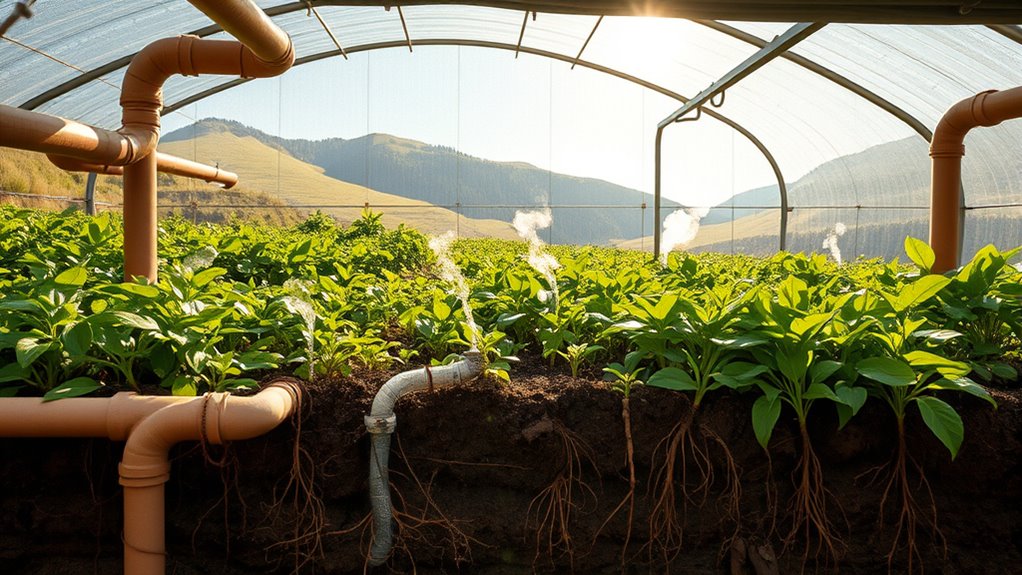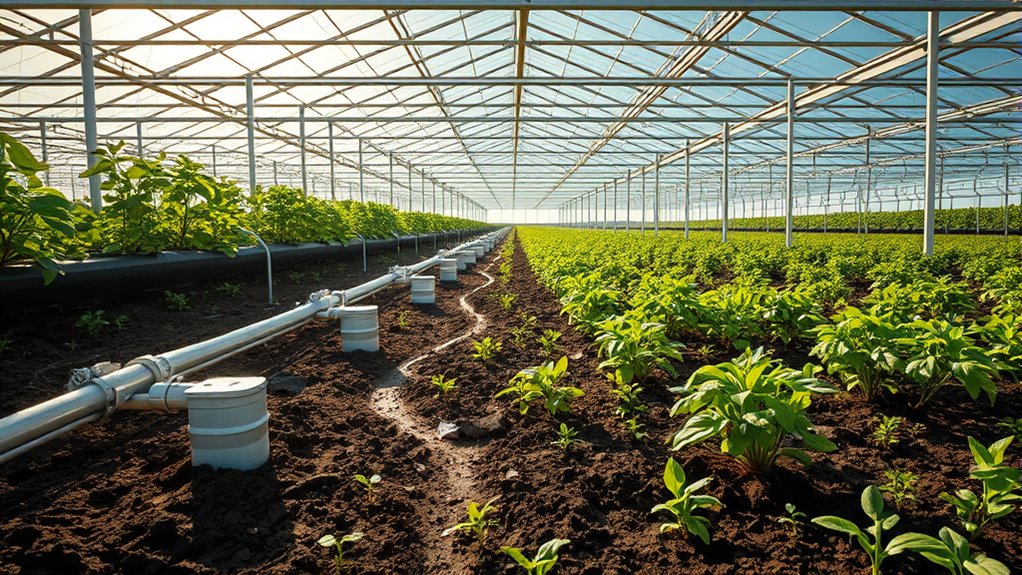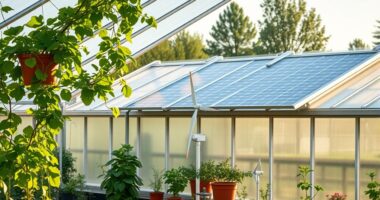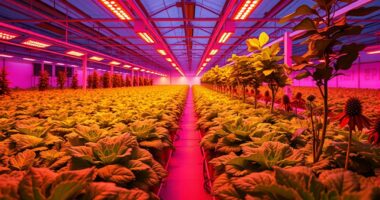Climate batteries and geothermal greenhouses harness Earth’s natural thermal energy to regulate indoor temperatures efficiently. By absorbing heat during the day and releasing it at night through underground chambers and thermal mass, you reduce reliance on artificial heating. This sustainable approach minimizes energy costs and the environmental footprint of your greenhouse. As you explore further, you’ll discover how leveraging Earth’s stable temperature creates resilient, climate-smart environments that work in harmony with nature.
Key Takeaways
- Climate batteries use underground thermal mass to store and release heat, maintaining stable greenhouse temperatures year-round.
- Geothermal greenhouses leverage Earth’s consistent underground temperatures for passive heating, reducing reliance on external energy sources.
- Both systems maximize solar heat gain during the day and utilize thermal buffering to retain warmth overnight.
- Incorporating underground chambers or pipes enhances energy storage, creating a natural, sustainable climate control system.
- These methods lower energy costs and carbon emissions while promoting eco-friendly, resilient farming environments.

Have you ever wondered how sustainable greenhouses can thrive with minimal energy input? The secret lies in harnessing Earth’s natural energy through techniques like passive heating and energy storage. Instead of relying heavily on artificial heating systems, these greenhouses use the earth’s stable temperature to keep plants warm, especially during colder months. Passive heating involves designing the greenhouse to maximize heat gain from the sun during the day and retain that heat overnight. This can be achieved with strategic placement, insulation, and thermal mass—materials like soil, water barrels, or stone—that absorb heat during the day and slowly release it when temperatures drop. By doing so, the greenhouse maintains a more consistent temperature without the need for constant energy input.
Energy storage plays a vital role in this process. When the sun shines, the greenhouse’s thermal mass absorbs heat, effectively storing it for later use. This stored energy then radiates back into the greenhouse during the night, reducing the need for supplemental heating. Think of it as a natural battery, where thermal energy is stored and released as needed. This approach minimizes energy consumption and lowers operational costs, making it an environmentally friendly alternative to conventional greenhouses. The design of a climate battery system often incorporates underground elements, such as pipes or chambers, which act as heat reservoirs. During the day, warm air or water circulates through these underground spaces, capturing excess heat and storing it beneath the surface. At night or during cold weather, this stored heat naturally radiates back into the greenhouse, keeping temperatures stable.
This cycle of passive heating and energy storage is highly effective because it leverages the natural thermal properties of the earth. The ground acts as a thermal buffer, moderating temperature fluctuations and providing a consistent energy source. Additionally, the earth’s stable temperature makes it an ideal medium for energy storage, which is crucial for maintaining greenhouse climate control. By integrating these principles into greenhouse design, you can create a space that’s resilient to external weather changes, reduces reliance on external energy sources, and promotes sustainable gardening or farming practices. This approach not only saves money but also markedly cuts down on carbon emissions, aligning with eco-friendly goals. Harnessing Earth’s energy through passive heating and energy storage transforms traditional greenhouses into efficient, climate-smart environments. It’s a smart way to grow your plants with minimal environmental footprint, proving that nature’s resources, when used wisely, can sustain us without excessive energy consumption.
Frequently Asked Questions
How Long Does It Take for a Climate Battery to Become Effective?
You might wonder how long it takes for a climate battery to become effective. Typically, it depends on factors like thermal response and moisture regulation, but you can expect noticeable improvements in a few months. As the system stabilizes, it gradually moderates temperature fluctuations and manages moisture. With consistent operation, you’ll see enhanced comfort and energy savings, usually within the first season, making the investment worthwhile over time.
What Are the Initial Costs of Installing Geothermal Greenhouses?
Imagine stepping into a lush, thriving greenhouse powered by Earth’s warmth beneath your feet. Your initial investment covers installation costs, which can range from $20,000 to $50,000 depending on size and system complexity. While these upfront expenses seem steep, they promise lower energy bills and sustainable growth in the long run. With proper planning, you’ll transform your space into an eco-friendly haven that harnesses geothermal energy effortlessly.
Can These Systems Be Used in All Climate Zones?
You might wonder if geothermal systems work everywhere. Their regional adaptability depends on local geology and climate limitations. In some areas, the ground’s temperature and soil conditions make installation easier and more efficient. However, in extreme climates, you could face challenges like higher costs or reduced efficiency. So, while these systems offer great potential, you should consider your specific location’s climate and geological factors before installation.
What Maintenance Is Required for Climate Batteries and Geothermal Systems?
Think of your system as a trusty steed needing regular care. You’ll want to check filters and clean them periodically to guarantee efficiency. Keep an eye on the system’s lifespan, replacing parts as needed to prevent breakdowns. Routine inspections and minor maintenance tasks help your climate batteries and geothermal systems run smoothly, saving you money and extending their longevity. Proper upkeep ensures your system remains a reliable energy source for years to come.
How Do Seasonal Changes Impact the Efficiency of These Systems?
You’ll notice seasonal energy fluctuations can affect system efficiency, as colder winters may reduce heat transfer, while warmer summers might cause overheating. However, these systems are designed to maintain temperature stability, helping you stay comfortable year-round. Their ability to adapt to seasonal changes minimizes energy loss, ensuring consistent performance. By understanding these effects, you can optimize system operation and enjoy reliable climate control regardless of outside temperature variations.
Conclusion
Now that you understand how climate batteries and geothermal greenhouses tap into Earth’s energy, imagine what’s possible as technology advances. Could these methods revolutionize farming and reduce reliance on fossil fuels? The potential is huge, but many questions remain. Will we harness this power to combat climate change or miss the chance entirely? Stay tuned—what’s coming next might just change the way you see our planet forever. The future of sustainable energy is closer than you think.









